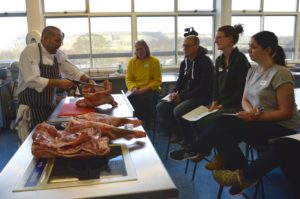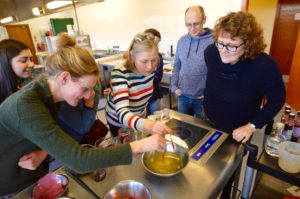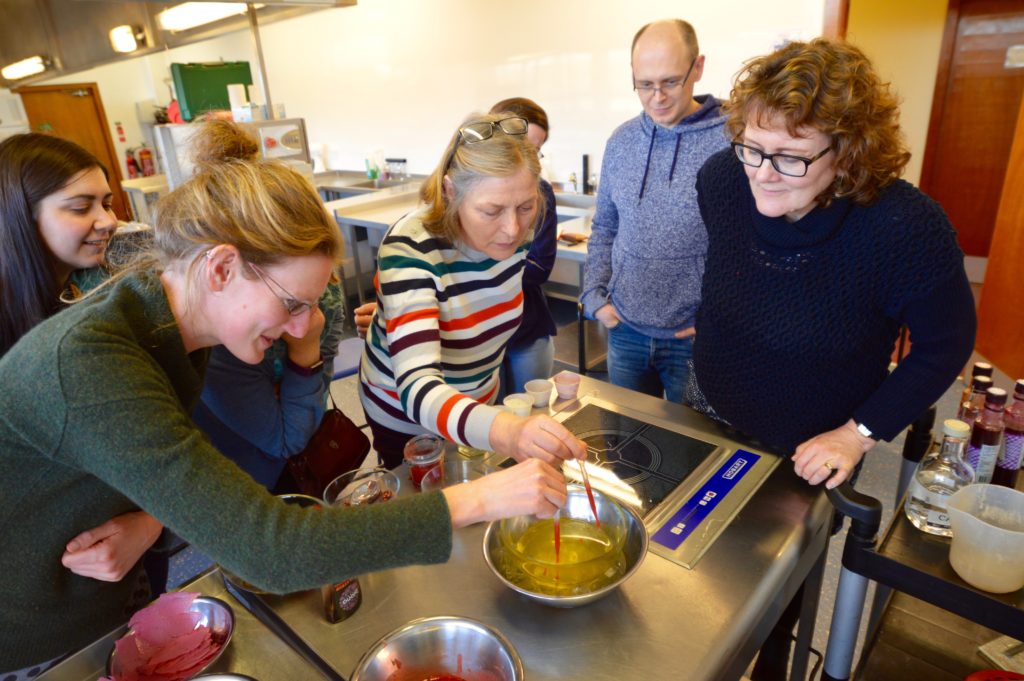Adding Value to Farm Produce – Event Summary
8 February 2018This two day introductory workshop on ‘Adding Value to Farm Produce’ was the first of its type within the Farm Advisory Service New Entrants to Farming Programme; taking a small group of enterprising farmers to develop and accelerate their ideas into practice. This course offered an opportunity to take that next step in progressing from the theory and act as a catalyst to spur development of their own added value food projects.
 The course was held in the teaching facilities at SRUC Elmwood where Lecturer (and qualified butcher), Willie Balfour, talked delegates through butchering a lamb carcase and opportunities to add value. A lot of information and discussion stemed from this demonstration session, including:
The course was held in the teaching facilities at SRUC Elmwood where Lecturer (and qualified butcher), Willie Balfour, talked delegates through butchering a lamb carcase and opportunities to add value. A lot of information and discussion stemed from this demonstration session, including:
- Don’t be intimidated by the carcase. It is fundamentally the same, whether working with beef, pigs or sheep, only the scale is different.
- Take time to understand the carcase and its cuts. That way you can add real value to the animal. If you are adding value you must be producing something your customer wants, which is inturn enhancing your USP. Think about the cost benefit of e.g. leg roast v’s deboned leg v’s leg steaks. And always ensure it is made appealing, convenient and easy for the customer.
Robert Logan, Livestock Business Consultant, SAC Consulting facilitated conversation, raising discussion about what type of food business they wanted to be and how they valued success. He then spoke to attendees about business appraisal and planning techniques.
Key messages were:
- When starting out think about cash needs first. How much do you require from the enterprise/business venture for private drawings and tax, loan capital repayments and business growth. By adding on operating costs to this will give a gauge for how many sales and what margin per unit sale is required each year. Do this to test rough viability before building a detailed business plan.
- Gain a good understanding of the end goal. It might change, but having no clear objectives wastes time and (potentially) money.
- Identify Key Performance Indicators (KPIs). These are not an end in themselves but it does tend to be that what we pay attention to grows and benchmarking and setting targets for a few key areas helps us pay attention.
- Be honest and open about the business ethos and objectives and refine that into your business plan so everyone knows what is important. Also, scenario test (stress test) the robustness of the plan e.g. if a significant input cost changed, a customer deferred payment, sales changed over forecast etc – and where possible have a plan to mitigate the negatives; be prepared.
He finished by saying little of this is easy. A few numbers on a scrap bit of paper is fine but much of it is about what you want the product/brand to be (ethos) and how that fits with market demand. The business plan should give confidence that there is enough margin left in the middle!
Mark Barker, Food Lecturer (and qualified Chief) provided the next demonstration session on adding-value to soft fruit – an industry that has grown rapidly in Scotland over recent years. Many of Mark’s messages rang true for branding or business planning e.g.
- Act fast – brain storm. Give yourself a short deadline to work under some pressure, it helps focus and blitzing ideas and avoids losing valuable months on research before you even decide what might work for you.
- Keep it simple. The more processes you put into a recipe the greater the risk of variability.
- Write it all down and once you have a formula, stick with it. You need consistency – note that a business plan is there to remove as many mistakes as possible on paper first, the same is true by writing down the affirmed recipe.
- Get to know what is trending. There is no point thinking you have a good idea if it doesn’t actually have a market.
- Don’t be scared of failure. Get started, if it doesn’t work, move on but learn from the mistakes. The drive is in finding solutions not in the solution itself.
 Ceri Ritchie, SAC Consulting Food and Drink Team provided an overview of the market place and understanding the market place before stimulating discussion in culturing thoughts on their own brand identity and how the logo/shape/service/price point/place of sale has to match that.
Ceri Ritchie, SAC Consulting Food and Drink Team provided an overview of the market place and understanding the market place before stimulating discussion in culturing thoughts on their own brand identity and how the logo/shape/service/price point/place of sale has to match that.
Roz Graham, SRUC Elmwood Hospitality Lecturer also managed to provide an engaging, interactive and informative workshop on food legislation from field to fork. Noting it is a huge but massively important area, the quiz coupled with ensuing debate and discussion provided an excellent started to engage those new to the food sector.
- Food Safety from Field to Fork
- A brief introduction to food safety
- Your Business Plan
- Ceri Ritchie explained about writing your business plan.
- Food Branding Summary
- What do you need to know before you start marketing your produce? Take a look to find out some useful hints and tips
Sign up to the FAS newsletter
Receive updates on news, events and publications from Scotland’s Farm Advisory Service

